Introduction
Prices of the private properties and public resale flats have risen across the board since early 2021. As expected, according to the recent data released by Urban Redevelopment Authority, the Singapore’s private home prices rose 0.9 per cent in the second quarter from the first quarter.
The price increase in the second quarter of 2021 was mainly driven by non-landed homes in the Outside of Central Region which increased by a higher 1.8% quarter on quarter in comparison. Prices rose the fastest for the OCR where the supply was limited as a result of the construction delays. It could also be due to OCR homes being the most affordable and having the strongest demand base. However, the price increase was marginal for the Rest of Central Region at 0.3% and 0.6% in the Core Central Region (CCR).
It can be explained by the fact that there were fewer launches in the three months from April to June, whereby Singapore introduce tighter restrictions at project sales galleries in the heightened alert period. Not only were there fewer new homes sold in second quarter of this year, but these typically carried higher price tags compared to properties in the resale market.
The price was quite evenly moderate across market segments within the CCR, RCR and landed market segments posting price increases of below 1%. The resale homes formed a higher proportion of transactions last quarter. As a result, the overall price index was pulled down by the lower prices. For the purpose of this article, we will be mainly focusing on the New Launch and Resale Markets in District 9,10,11, looking at the price gaps in these Districts specifically.
Let us first discuss about the overall private properties market segment. Based on URA Realis data, the number of new private homes excluding executive condominiums sold in 2Q2021 was 2,617 units, while the number of resale properties was 57 per cent higher at 4,100 units despite the limited launches and tighter safe management measures.
The average unit price of private new homes sold excluding executive condominiums rose 1.6% quarter on quarter in second quarter of 2021, while that of resale properties increased 1.7% qoq. Clearly, the evident price gap between new launches and resale properties that are in move-in condition and the preference for bigger space typically found in older apartments have helped boost demand for homes in the secondary market, therefore supporting these prices. We will now discuss about the new launches and resale markets transactions in these districts 9, 10, 11 over the past five year (2016-2021).
2016 – 2021 CCR Transactions New Launches vs Resale markets
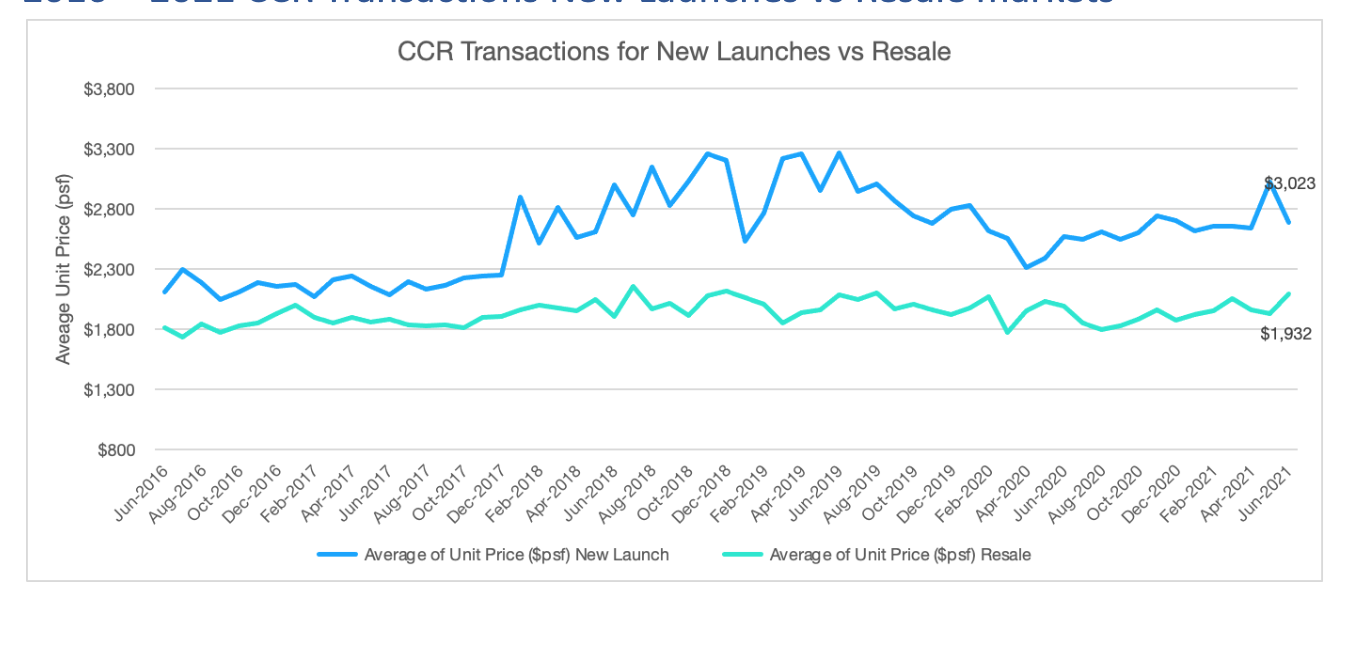
Source: URA
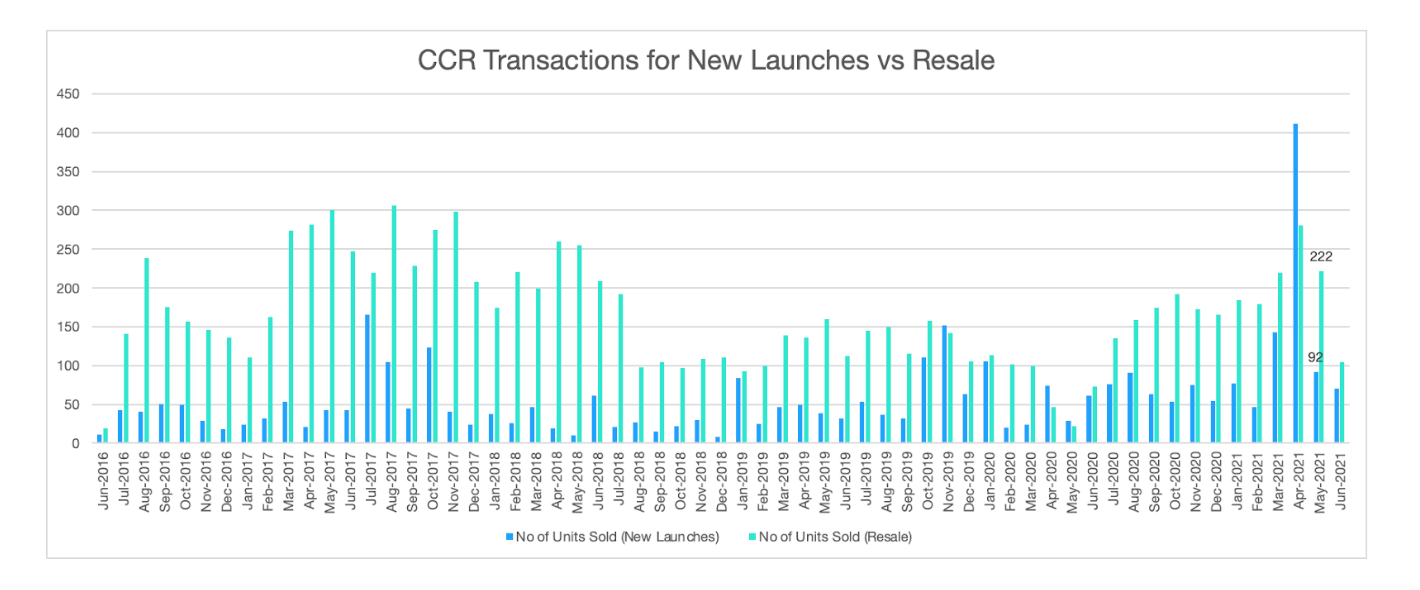
Source: URA
Based on the URA data tabulated by PropertyLimBrothers, in terms of the transactions in District 9,10,11, the price gap between the resale and new launches market segments has widened significantly over the past 5 years. It is also worth mentioning that the unusual spike in the take-up rate for the New launches in April 2021 is largely due to the successive sales of Irwell Hill Residences (District 9) with a total number of 307 units sold in April.
What buyers should consider are the prices of the condominiums in these districts. Within these districts, the price gap is so wide that it’s more sensible to get resale condominiums. The second quarter of this year also saw fewer new launches during Singapore’s heightened alert period. This has pushed down property prices as new homes are generally sold at higher prices compared with resale homes in the second quarter of 2021.
All in , the property market is also being driven by strong demand from Housing Development Board buyers looking to upgrade, lower interest rate and a recovering economy. Genuine homebuyer demand remains healthy from HDB upgraders whose homes have recently passed the 5-year Minimum Occupation Period and are looking to cash in.
The HDB Resale Index rose by 2.8% q-o-q in 2Q2021 based on recent published flash estimate, outperforming the private home price movements for the second quarter of 2021. The proceeds from the resale of HDB flats have allowed homebuyers to transit into the private residential market, This is especially the case, if these are nuclear families comprising young working couples who have benefitted from general wage increases in the past decade as shown in the Population Census 2020.
This suggests that the rise in affluence over the past decade has provided the momentum for growth in demand for private properties. The present resilience of the private home market comes at a time when the current low interest rate environment bodes well for the homebuyers as the mortgage remains affordable.
2016 – 2021 CCR Transactions by Tenure
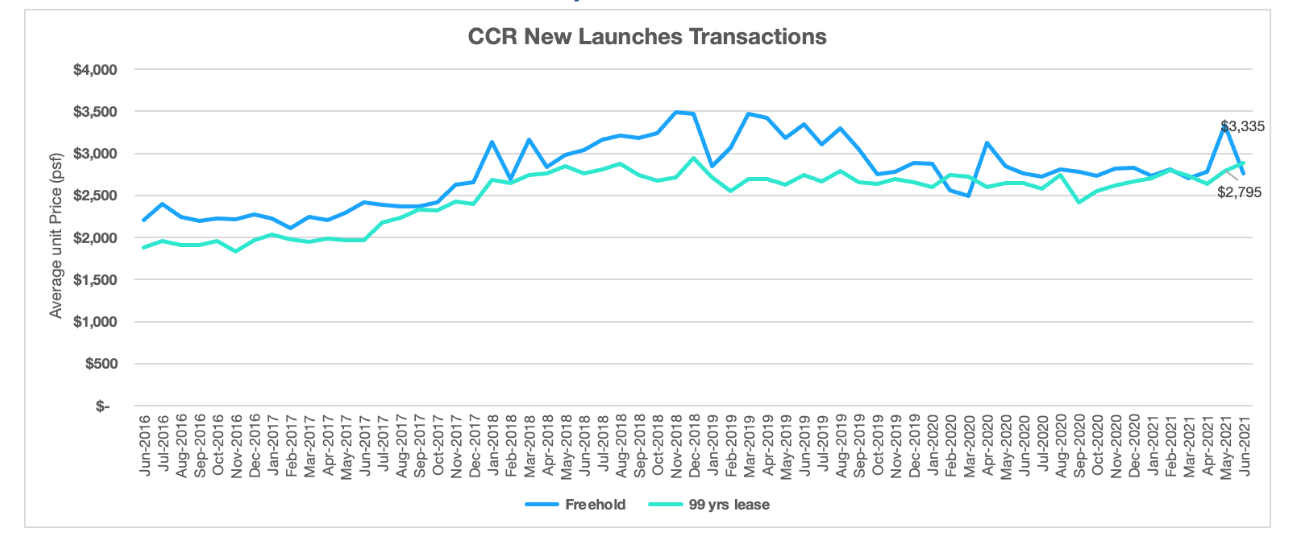

Source: URA
Looking at the URA data tabulated by PropertyLimBrothers, over the last year, the freehold condominiums have appreciated over the past five years. In terms of new launches, the prices of the freehold trail those of the leasehold property over the last year, although we do see the price gap widened from July 2018 to late 2019, but has narrowed over the last year.
We see that the prices of the 99 years resale leasehold are comparatively lower than those of the freehold. It also makes sense that a 99-year leasehold would outperform in terms of gross rental yield. Tenure has little to no effect on rents. Hence, for similar homes with different tenures, freehold landlords would rent out their units for the same price as that of 99-year leasehold owners. However, the cost of freehold property is much more expensive than that of a 99-year leasehold. This essentially hurts the freehold owner when it comes to gross rental yield income.
In terms of capital appreciation, freehold owners came out ahead in CCR over the last year, as prices increased by 6% compared with a 33 per cent decline for 99-years leasehold owners. Generally, it would mean that it may not be worth paying a higher premium for a freehold condominium if you do not plan to live in the home for a long period of time. It also suggests that if you are a landlord, go for the 99-year leasehold.
Additionally, there are a number of reasons that may have contributed to the improved higher price. First, the potential developments in the areas may have boosted buyers’ interest in non-landed properties located in these districts, contributing to a price increase over the last year. Second, given the price gap between buyers and sellers, improvements in prices may be suggesting that the sale of choice properties, where buyers were willing to bridge the price gap by paying a premium.
Further, there has been an increased demand from foreign buyers since March, which may have supported prices in the Core Central Region. Looking ahead, we will expect the prices to improve which is supported by demand for new private residential properties in these areas.
2016 – 2021 CCR Transactions by Floor Level
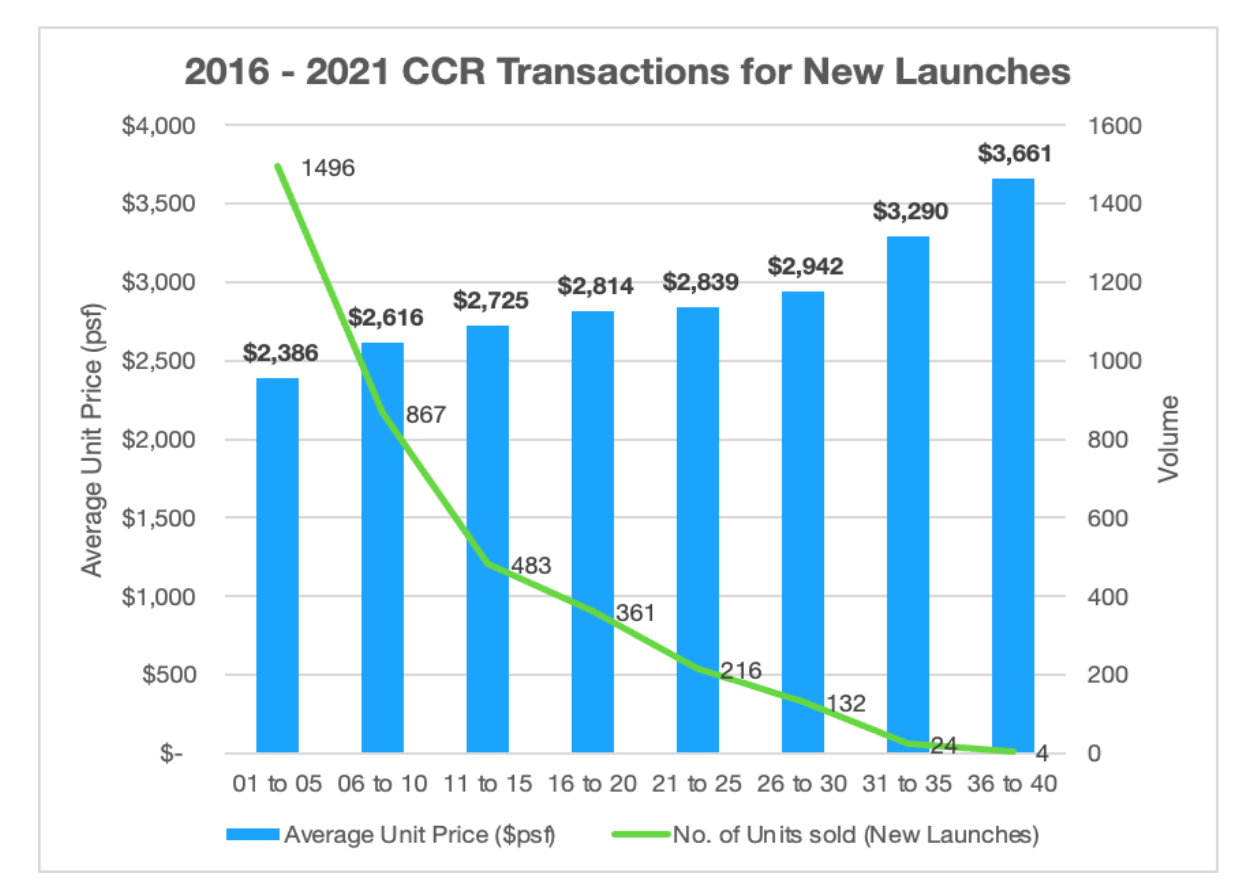

In terms of New Launches, the median unit price of the low rise(floor 1- 5) condos is going for 2,560psf in May 2021, 12% higher than 2,280psf in May of last year. The Total units sold( floor 1 -5) for the first half of 2021 is 249, rose by 72% as compared to 144 unit sold in the first half of 2020.
Generally, the higher floor ( level 36 or higher) Resale units are going for an average price of $2318psf and more as the extra premium homebuyers paying reflects the demand for more privacy and better views. In some cases, the buyers will get to enjoy unblocked views that are high up with a less chance of getting obstructed views.
According to the URA data, the lower cost is usually associated with low-rise units (floor 10 and below) as the resale units (floor level 6 – 10) cost a median price of $1,893 psf over the past 5 years. By buying the lower floors units, the owners not only get to enjoy the cost savings but also enjoy greenery or pool views as any units higher, the owners would have to be at the balcony in order to enjoy the views. Having said that, the pool view units might be preferred by some people who are on a budget.
Let us now look at the price quantum for the different unit sizes in these districts.
2016 – 2021 CCR Transactions by Size (sq ft)
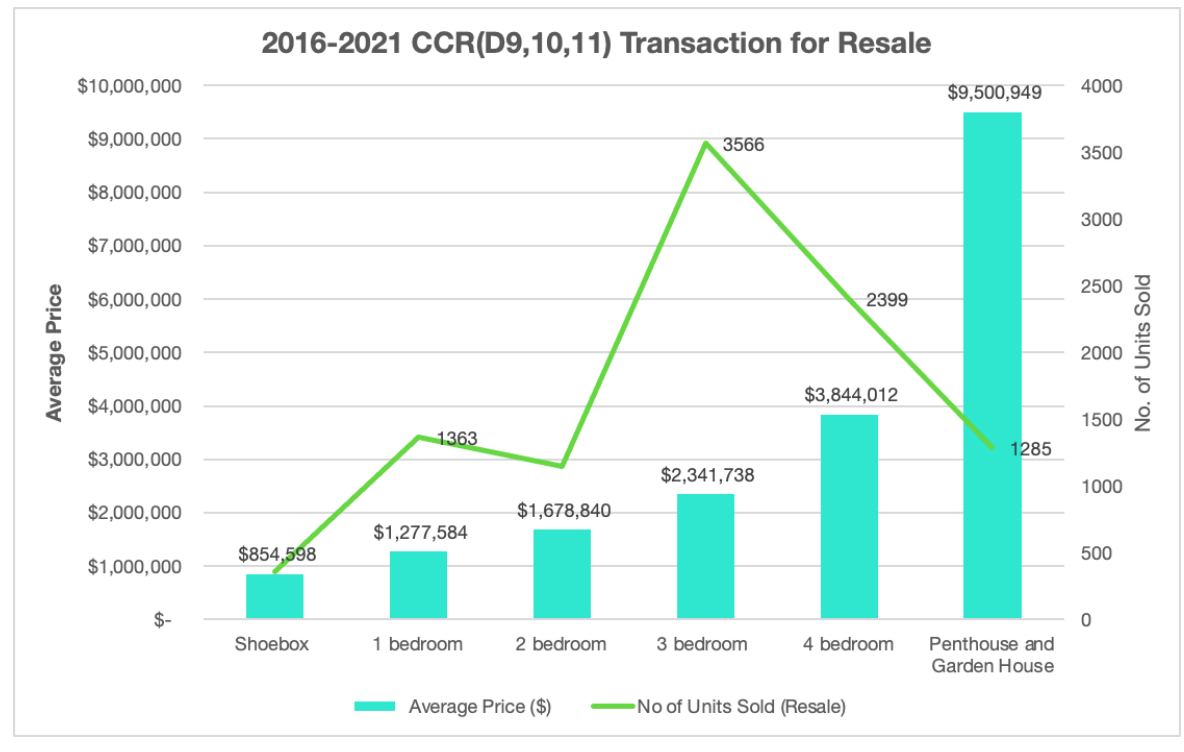
Source: URA
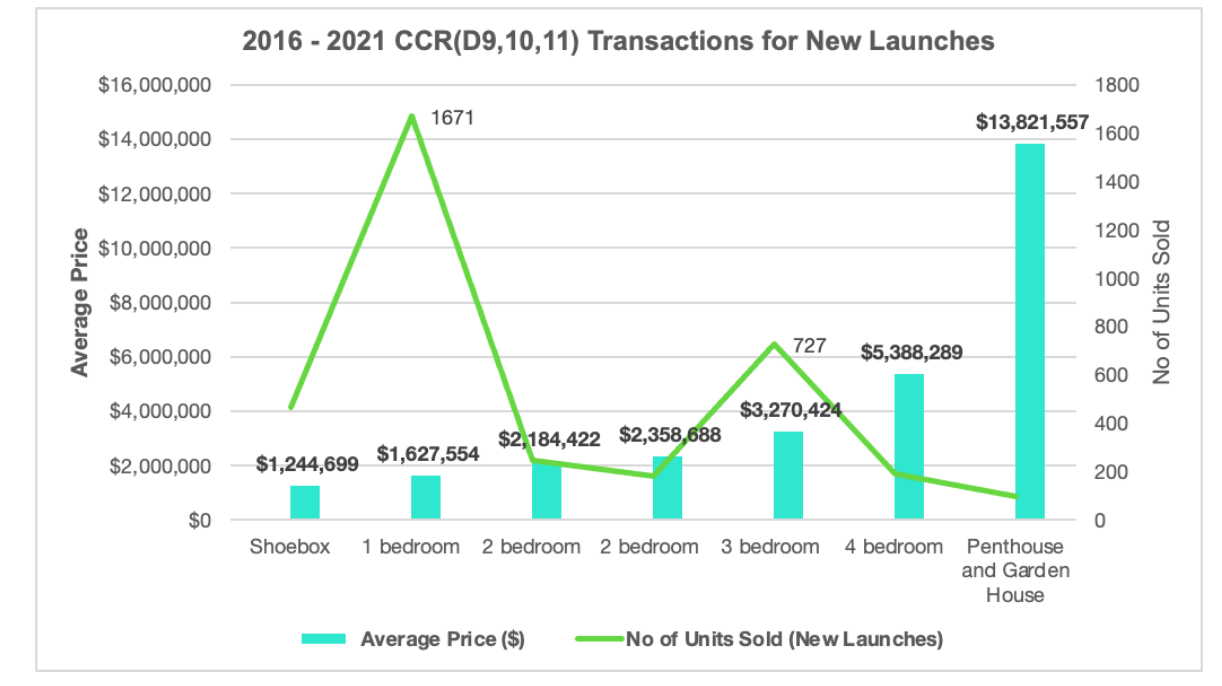
Source: URA
For the purposes of this discussion, we will define a shoebox unit as being condominium or apartment property of 500 square feet. The units may be slightly bigger or smaller, but it is the typical size of a one-bedder.
We examined the prices of shoebox units in the Core Central Region, specifically Districts 9, 10, 11. Based on the URA data, in terms of resale home, the shoebox resale units in the D9,10,11 are selling at an average quantum of $854,598, with an average price of $2,097.47psf.
According to the URA data tabulated (accurate as of 1 July 2021), the price of the average condo for 3 bedrooms is about $2.34 million, while the price of the average 3-rooms new launch home is about $3.27million. Clearly, the gap between the average price of new launch projects and a private resale property widened significantly. Further, the proportion of these larger home transactions rose in 2Q2021. Space has become a prized asset as many homeowners saw their daily lives suddenly confined to their home. Many owners were looking for homes with outdoor space and bigger areas. According to the URA statistics, in the last quarter, about 40% of private homes which comprise of landed and non-landed segments were 1,200 sq ft or bigger, higher than the 36% in 1Q2021. Therefore the bigger units probably explain the lower per square foot prices for some properties in these districts.
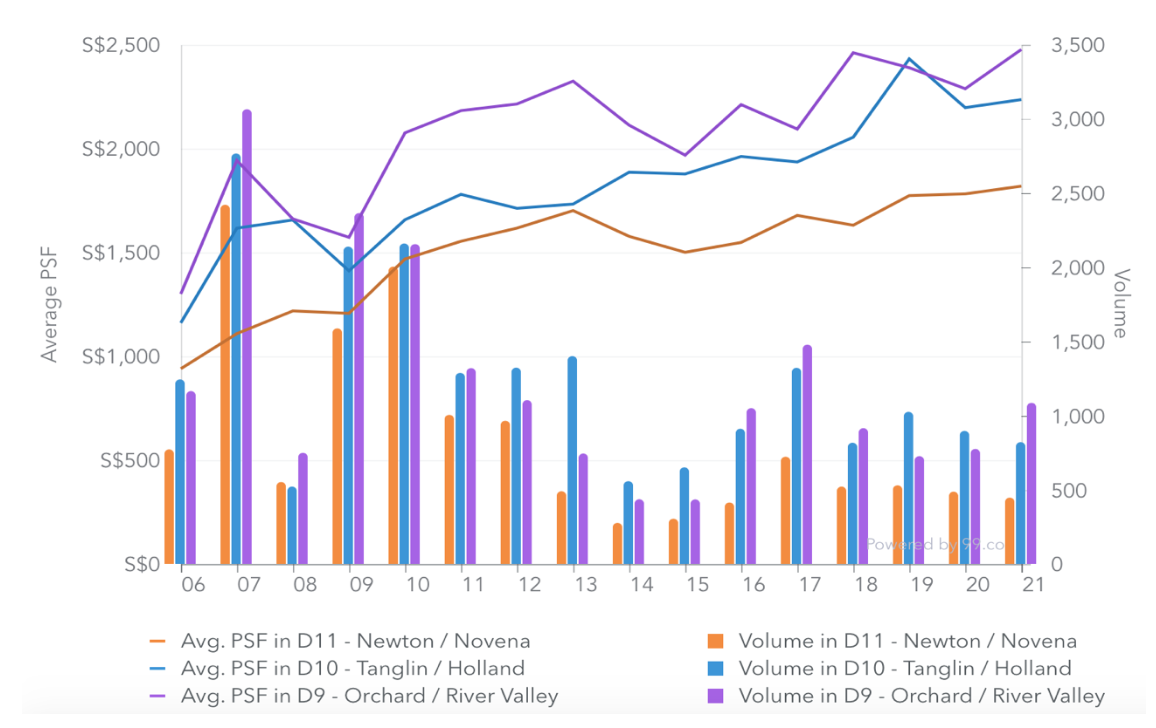

For a fairer comparison, let’s look at leasehold versus freehold condominiums specifically in the Orchard (District 9) area.
We’re using this prime location as comparison because it’s a centralised area, and most of the condominiums – freehold or leasehold – have appreciated significantly over the past decade. Also, many of the condominiums in this area are designed and constructed to the same quality of high standards. Over the past decade, leasehold condominiums in District 9 appreciated more than freehold counterparts. Leasehold units saw a rise of 77 per cent in per square foot price, while freehold counterparts only rose around 52 per cent. Similarly, District 15 leasehold properties also saw a higher appreciation in price per square foot compared to freehold counterparts.
Therefore for home buyers, who are less interested in price appreciation, freehold should not be their choice. As it is usually more costly, the 10 to 15 per cent premium that the homebuyers are paying can affect their affordability. Also, homeowners often sell and move out long before the 99-year lease is up, when they decide to upgrade. In these cases, they would have paid more for a freehold unit.
Why consider a 1 Bedroom Condominium, instead of just right-sizing to a flat?
Also, as mentioned earlier, in new launches projects, we see that 1 bedroom unit is the preferred choice as it is relatively affordable with the lower quantum considered.
As such, someone rightsizing from a larger condominium unit will probably be able to cover the entire cost of the 1 bedroom condominiums with the sale proceeds, even if they choose to buy in the prime districts. Even so, they will even have a substantial amount left to fund their retirement.
Moving to a 1 bedroom condominium unit from a HDB unit is more challenging, especially if you’re older and financing isn’t available. So why consider a 1 bedroom condo unit, instead of just right-sizing to a flat?
-
Due to the comparatively lower quantum, some people can afford two properties
-
Exclusive Access to condo facilities
-
The possibility to get a freehold unit
-
No HDB restrictions
-
Maintaining the option of Cash-Out Refinancing
1.Due to the comparatively lower quantum, some people can afford two properties
If someone gets a flat, he/she will have to lose their existing property, meaning that he/she can’t buy an HDB flat while holding on to their previous home. Homebuyers can, however, do this with a 1 bedroom condominium unit as this gives them the opportunity to live in the condominium, while renting out their old home for income.
The concerns that you might be having here is the Additional Buyers Stamp Duty. If you buy a condominium on top of your existing property, it will cost you another 12 per cent (ABSD) or 15 per cent if you’re a Permanent Resident.
However, 1 bedroom condo units have a low quantum, making this more affordable. For example, 12 per cent ABSD on a $1 million 1 bedroom condo unit is just $120,000.
For older Singaporeans with accumulated savings, it may be feasible to own a 1 bedroom condominium as a second property, and live in it.
2. Exclusive Access to the condominium facilities
Condominiums have pools, gyms, BBQ pits and other amenities. Having said that, it’s the more active retirees who will really get the most benefit from these condominium facilities.
Besides the common facilities, one can choose 1 bedroom condominium in the areas whereby development plans have been laid out in this region. These can provide them with the connectivity, nearby restaurants, supermarkets, banking facilities, new train stations that are being developed in the areas.
This may be appealing to older Singaporeans who don’t want to travel out too much. As many elderly residents wouldn’t even consider leaving their house and would find the ease of staying in these areas an attractive attribute.
3. The possibility to get a freehold unit
Some investors are interested in legacy planning, which includes leaving a property to their children. This may exclude HDB flats, which are on 99-year leases; and flats may not be inheritable anyway. If the children already own private property, they’ll just have to sell the flat right after the will leaves it to them. They could, however, retain both their private property and the 1 bedroom condominium willed to them.
As freehold units come at a premium which are usually priced typically around 20 per cent more than leasehold units – the lower quantum of 1 bedroom condominium might be a good choice for these buyers.
4. No HDB restrictions
People who already live in condominiums may find HDB restrictions cumbersome. An example is if they keep certain dog breeds, which HDB does not allow.
They may also dislike the lack of voice in how the estate is run: HDB has its town councils and listens to feedback, but individual owners don’t have as much control as they would over a condo MCST.
In our experience, the density of HDB flats can also be a turn-off, to people who are accustomed to living in the condominium. For example, there may just be one other neighbour on the same floor of a condo unit; but in an HDB block there are a whole stretch of units on each level, and some people may find there’s too much noise and little privacy.
5. Having the option of Cash-Out Refinancing
Cash-Out refinancing allows the homebuyers to take out a loan against the equity of your home, at low interest rates. For example, one may be able to borrow up to 80 per cent of the value of your home, at rates as low as one per cent.
This option doesn’t exist for HDB flats, and it is only for pr
ivate properties. For retirees looking to benefit their children, note that beneficiaries could potentially take out such a loan on the 1 bedroom condominium property, after they inherit it. For a 1 bedroom condominium unit valued at $1 million, that’s a loan of up to $800,000, at an interest rate of just around one per cent. At the same time, their children or grandchildren would also retain and be able to rent out 1 bedroom condominium even after taking such a loan.
Having said that, before you decide to right-size into a 1 bedroom condominium, there are some important factors to consider, such as:
-
Maintenance fees
-
The high costs of common facilities
-
Potential disruptions from en-bloc sales
1. Maintenance fees
This is often what kills the deal, for homebuyers considering a 1 bedroom condominium. Condo maintenance fees are around $70 to $80 per share value; and can be even higher for CCR properties. For many 1 bedroom condominium units, homebuyers would still be spending around $200 per month. It typically costs over $1000 for luxurious condos and cluster landed homes.
Further, these maintenance fees continue throughout, and homebuyers will be paying them well for a long period of time. So you might be enticed by the low quantum initially; maintenance fees also form part of your monthly cost.
2. High Costs of Common Facilities
In terms of maintenance fees, the cost of a 1 bedroom condominium unit is seldom justified if one has no use for the facilities. It might be better for them to save the funds for travel, healthcare as opposed to paying for pools and gyms that they’re not going to utilise.
3. Potential Disruptions from En-bloc sales
HDB flats can also fall under SERS or VERS, and force residents to move. In practice, collective sales are far less likely in an HDB development than a private condominium.
Typically, many condos don’t make it past their 40th year into the lease without an en-bloc sale happening. For some people who move into older developments, it may sometimes prompt moving again should an en-bloc happens. This can be largely disruptive for seniors especially if they don’t qualify for contra loans, and need to find a new place before they have received the sale proceeds from an en-bloc.
There are cases whereby some homebuyers who happened to right-sized into a one-bedder, and then the development went en-bloc in their second year. Not only did he have to move again, he had to pay eight per cent of Sellers Stamp Duty, and spent on the sunk cost of the renovations they had done to their one-bedder.
Hence, it is advisable to avoid right-sizing into a development that is in the process of an en-bloc sale, or that came close recently.
Having said that, for now, many of the older developments that you see around that are potential for en-bloc sales don’t usually have 1 bedroom units as they usually start from two bedders and up, so it may not be a concern.
A 1 bedroom condominium can be sufficient and practical for an individual, newly wed couples, retirees or even expatriates. They can also enjoy access to condominium facilities, a higher standard of interior finishing than a flat, and possibly, even a better location. For instance, they may be unable to afford a full-sized condominium in District 9, but a shoebox apartment in this location might not be out of the picture
Also, consider the demographic of singles, who are not able to attain an HDB flat but want a place of their own. They could consider to buy a shoebox condominium unit as it may be affordable, given the low quantum. Again, elderly Singaporeans, whose grown-up children have moved out of the family home, may consider moving into shoebox units too. Those with bigger budgets may prefer the luxury of a small resale or new condominium, rather than, a three-room or smaller flat. Those who are accustomed to staying in condominium may also prefer to rightsize from a full-sized condominium to a smaller one, rather than moving into a flat.
Conclusion
When choosing between a brand new launch and a well-maintained resale condo for your investment property or personal stay, you have to consider whether you are a new landlord or investor. As mentioned, it is advisable to plan the costs carefully thoroughly; however how low the quantum are for resale homes as compared to the new launches property, they still remain as a pricier alternatives in some locations as we discussed in this article.
All in, investing in resale units are deemed less riskier for new landlords, while new launches are best catered for the seasoned investors to assess their options. We hope you find this article useful in highlighting some insights on whether a new launch or resale home is a more justifiable purchase for you and about its benefits and concerns. Stay tuned for the next PLB Insights article! For those who are interested in finding out more or would like to start planning for your property portfolio, you may contact our PropertyLimBrothers team.








